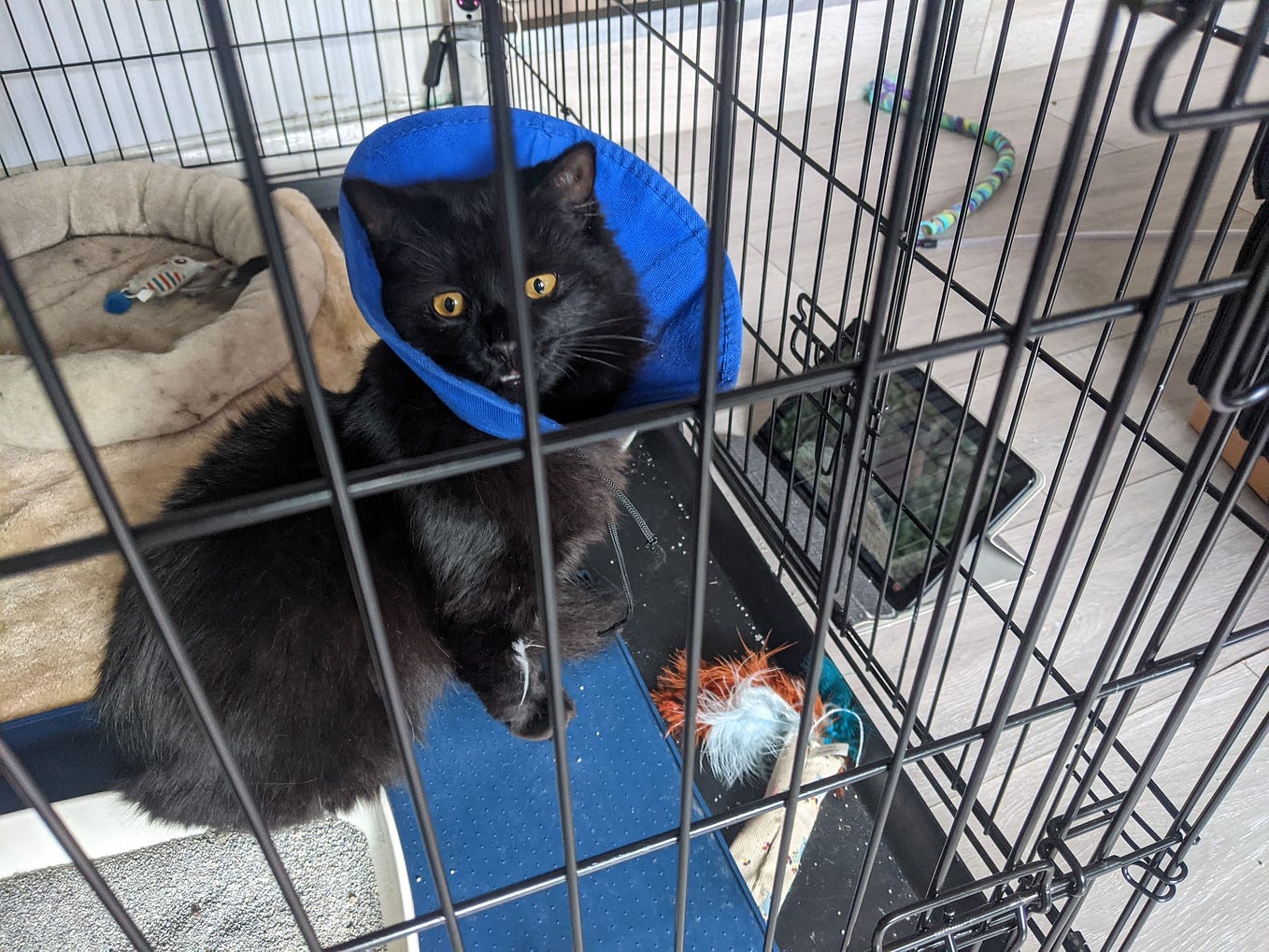Cage rest is a treatment plan for cats following extensive surgery or trauma. During this time, cats must stay confined in a cage to support their recovery. This confinement is similar to human bed rest and is crucial to their healing process.
However, ensuring the cat is comfortable and provided with exercise and social interaction opportunities is important to avoid negative behavioural effects. Extended periods of confinement are not healthy for animals.

Credit: medium.com
What Is Cat Cage Rest?
Cat cage rest is a crucial treatment plan for injured cats, especially after extensive surgery due to a Road Traffic Accident. Like bed rest for humans, cage rest helps cats recover fully, making it just as essential as the surgery.
However, extended periods of confinement are not healthy for cats, so it’s important to provide opportunities for exercise and social interaction.
When cats are injured in a Road Traffic Accident, they are often required to be on cage rest, the feline equivalent of bed rest, following extensive surgery. A treatment plan involving cage rest can be just as critical as the surgery in helping them fully recover.
Purpose Of Cage Rest
Cage rest serves as a necessary precautionary measure to promote healing and prevent further injury or complications. The primary purpose of cage rest is to limit a cat’s physical activity and provide a controlled environment for them to recuperate.
Importance In Recovery
Cage rest plays a crucial role in recovery, especially for cats with conditions such as broken bones, post-surgery wounds, or extensive injuries. Keeping the cat confined ensures that their movements are restricted, reducing the risk of re-injury and allowing the body to heal more effectively.
Treatment Plan
A proper treatment plan for cat cage rest is essential for a successful recovery. The following guidelines can help ensure the cat’s well-being:
- Provide a comfortable and spacious cage or crate that allows the cat to stand, turnwellbeingnd lie down comfortably.
- Line the cage with soft bedding to promote comfort and prevent bed sores.
- Keep the cage in a quiet and low-stress area of the house to minimize disturbances.
- Offer regular meals and fresh water to maintain proper nutrition and hydration.
- Administer medication, if prescribed, as directed by the veterinarian.
- Engage in gentle interaction and play to provide mental stimulation while avoiding excessive physical activity.
- Follow regular veterinary check-ups and adhere to their recommendations for the cage rest period.
Remember, while cage rest may initially be challenging for both the cat and the owner, it is a crucial part of recovery. With proper care and attention, cats can make a full recovery and regain their freedom once again.

Credit: www.reddit.com
Is Cage Rest For Cats Cruel?
When cats are injured in a Road Traffic Accident, they are often required to be on cage rest, the feline equivalent of bed rest, following extensive surgery. A treatment plan involving cage rest can be just as critical as the surgery in helping them fully recover.
Behavioural Problems
Cats can feel trapped and may not behave well when confined to such a small space. They can also become anxious, leading to behavioural problems, including scratching furniture or spraying around the house.
Anxiety Issues
Being confined to a cage can cause cats to experience anxiety. This can manifest in various ways, such as excessive grooming, meowing, hiding, or aggression. Cat owners need to be aware of these signs of anxiety and take steps to alleviate their cat’s stress.
Alternatives To Cage Rest
While cage rest may be necessary for some cats, alternative options can be explored to ensure their comfort and well-being. Some alternatives include:
- Providing a large, comfortable enclosure or playpen where well-being move around more freely
- Using calming pheromone sprays or diffusers to help reduce anxiety
- Enriching the cat’s environment with toys, scratching posts, and hiding spots to keep them mentally stimulated
- Implementing a structured exercise routine under the guidance of a veterinarian
These alternatives can help reduce the negative effects of confinement and promote a healthier recovery for the cat.
It is important to consult a veterinarian to determine the best course of action for a cat requiring rest and recovery. Each cat’s needs may vary, and it is crucial to provide the appropriate care to ensure the cat’s well-being.
Tips For Cats On Cage Rest
Cage rest is crucial to a cat’s recovery after a well-being injury. Although cats may feel trapped and anxious in a small space, it is necessary for their well-being, allowing them to heal properly without causing further harm.
Providing plenty of exwellbeing social-being and outside the cage is essential to maintaining physical and mental health.
Creating A Comfortable Environment
Cage rest is a crucial part of the recovery process for cats, particularly after extensive surgery or a traumatic event. To ensure your furry friend stays comfortable during this period, it’s important to create a soothing environment within the confinement of the cage. Here are some tips:
- Choose the right size: Choose a cage large enough for your cat to stand up, stretch, and move around comfortably.
- Add soft bedding: Line the cage with cozy blankets or pet-specific bedding to provide a comfortable surface for your cat to rest on.
- Create a hiding spot: Place a small covered box or igloo bed within the cage to provide a secluded area where your cat can retreat and feel safe.
- Provide proper ventilation: Ensure the cage is well-ventilated to maintain your cat’s fresh and comfortable environment.
- Keep the cage clean: Regularly clean the cage to prevent odours and maintain a hygienic space for your cat.
Managing Boredom
Cage rest can be challenging for cats, limiting their ability to engage in their usual activities. To prevent boredom and keep them mentally stimulated, try the following:
- Interactive toys: Provide toys that require mental engagement, such as puzzle feeders or treat-dispensing toys, to keep your cat entertained.
- Rotate toys: Regularly change the toys within the cage to prevent boredom and maintain your cat’s interest.
- Enrichment activities: Consider using cat-friendly interactive games or play sessions to stimulate your cat mentally.
- Sensory stimulation: Incorporate elements that stimulate the senses, such as playing calming music or providing a view of the outdoors through a window.
Pain Management And Comfort
Promoting your cat’s comfort and managing pain is essential during cage rest. Here are some tips to ensure their well-being:
- Provide pain medication: Follow your veterinarian’s instructions and administer any well-being pain medications to alleviate discomfort.
- Monitor body temperature: Keep the cage in a warm area and provide additional warmth, if needed, to help your cat stay comfortable.
- Calming aids: Consider using pheromone diffusers or natural calming sprays to create a serene environment that promotes relaxation.
- Gentle massage: Offer gentle massages to help alleviate muscle tension and provide a soothing experience for your cat.
- Veterinary check-ups: Regularly schedule check-ups with your veterinarian to assess your cat’s progress, adjust pain management, and address concerns.
By following these tips, you can ensure that your cat’s cage rest experience is as comfortable and stress-free as possible, helping them on their journey to a full recovery.

Credit: www.catsmatter.org
Frequently Asked Questions Of Cage Rest Cat
What Is Cat Cage Rest?
Cat cage rest is a treatment plan for injured cats, often after surgery, in which they are confined to a cage. It is like bed rest for humans and is critical for their full recovery. However, it is important to provide exercise and social interaction opportunities to ensure their well-being.
Is It Cruel To Leave A Cat In A Cage?
Keeping a cat in a cage for extended periods of well-being leads to anxiety and behaviour. Cats need space to roam and exercise. Confine them only when necessary, ensuring they have plenty of opportunities for exercise and social interaction.
Is It Healthy To Put A Cat In A Cage?
Cage rest can be healthy for a cat when supervision or quiet rest periods are needed. Adequate exercise and social interaction should be provided, and extended periods of confinement are not recommended.
Is It Bad To Leave A Cat In A Cage Overnight?
Leaving a cat in a cage overnight can be stressful and lead to behavioural problems. It is best to avoid crating unless necessary, such as for litter box training. If confinement is needed, consider a quiet room with a cage to provide a comfortable environment for the cat.
Alternating the cage’s position can also help.
Conclusion
Cage rest is crucial to a cat’s recovery after surgery or injuries. It provides the necessary time and space to heal. While it may seem confining, it significantly prevents further damage and promotes a quick recovery.
However, it is important to ensure that cats on cage rest receive ample exercise and social interaction opportunities to maintain their overall well-being. Cage well-being contributes to recovery by following the right guidelines and providing a comfortable environment.

